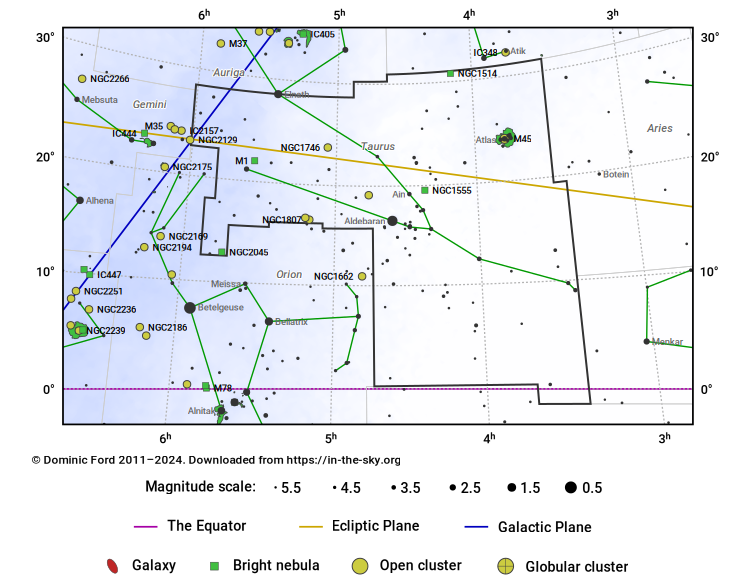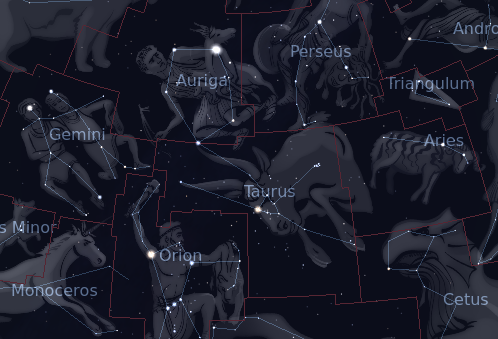The Constellation Taurus
Taurus is a prominent northern constellation, lying immediately north-west of Orion. It is highest in the evening sky in the months around December.
Two objects in Taurus stand out to the unaided eye: the bright star Aldebaran, the thirteenth brightest in the whole sky, and the Pleiades star cluster (M45). The Pleiades is one of the brightest of all open clusters, visible to the naked eye as a smudge. In ancient times it was known as the ‘seven sister’, though only six stars are actually visible without optical aid.
Aldebaran itself lies within another bright star cluster, the Hyades cluster which forms a V-shape.
Taurus is depicted as a bull, within which the Hyades cluster forms the bull's head. North-east of this, the stars β-Tau and ζ-Tau mark the tips of the bull's horns. Close to the bull's right horn lies another remarkable deep sky object, the Crab Nebula (M1), which is the remnant of a supernova explosion seen by Chinese observers in 1054.
The association of Taurus with a bull predates Greek mythology, and the Sumerians linked the bull with Orion, supposing the hunter to be facing the charging animal. In Greece, however, Orion was associated instead with the two hunting dogs Canis Major and Canis Minor, in pursuit of the hare Lepus. Instead, according to some accounts, Taurus perhaps depicted Zeus, who took the form of a bull in order to abduct Europa.
Taurus is one of the twelve zodiacal constellations, and the Sun passes through it each year between mid-May and mid-June.
Ancient
1.9% of the sky
797.2 square degrees
Hover the pointer over the name of an object to highlight its position on the starchart to the right, or click to see more information.
| Stars | Open Clusters | Globular Clusters | Galaxies |
| Aldebaran (mag 1.0) | Caldwell 41 (mag 1.0) | NGC 1587 (mag 11.7) | |
| Elnath (mag 1.7) | Messier 45 (mag 1.3) | NGC 1589 (mag 11.8) | |
| Alcyone (mag 2.9) | NGC 1746 (mag 6.1) | NGC 1615 (mag 12.0) | |
| ζ-Tau (mag 3.0) | NGC 1647 (mag 6.4) | NGC 1550 (mag 12.1) | |
| θ²-Tau (mag 3.4) | NGC 1807 (mag 7.0) | NGC 1642 (mag 12.6) | |
| λ-Tau (mag 3.4) | NGC 1817 (mag 7.7) | NGC 1349 (mag 13.1) | |
| Ain (mag 3.5) | NGC 1750 | NGC 1541 (mag 13.5) | |
| Atlas (mag 3.6) | NGC 1758 | NGC 1590 (mag 13.7) | |
| O-Tau (mag 3.6) | NGC 1802 | NGC 1474 (mag 13.8) | |
| γ-Tau (mag 3.6) | NGC 1996 | NGC 1542 (mag 13.9) | |
| Electra (mag 3.7) | NGC 2026 | NGC 1588 (mag 14.1) | |
| ξ-Tau (mag 3.7) | NGC 1517 (mag 14.2) | ||
| δ-Tau (mag 3.8) | NGC 1633 (mag 14.5) | ||
| θ¹-Tau (mag 3.8) | IC 1977 (mag 14.6) | ||
| Maia (mag 3.9) | NGC 1497 (mag 14.6) | ||
| ν-Tau (mag 3.9) | IC 357 (mag 14.6) | ||
| f-Tau (mag 4.1) | NGC 1593 (mag 14.7) | ||
| Merope (mag 4.2) | NGC 1409 (mag 14.8) | ||
| κ-Tau (mag 4.2) | IC 331 (mag 14.8) | ||
| τ-Tau (mag 4.3) | IC 365 (mag 14.8) | ||
| d-Tau (mag 4.3) | IC 338 (mag 14.9) | ||
| V776 Tau (mag 4.3) | IC 1967 (mag 14.9) | ||
| c¹-Tau (mag 4.3) | NGC 1634 (mag 15.0) | ||
| μ-Tau (mag 4.3) | IC 330 (mag 15.0) | ||
| υ-Tau (mag 4.3) | IC 329 (mag 15.1) | ||
| Taygeta (mag 4.3) | IC 2057 (mag 15.2) | ||
| 10-Tau (mag 4.3) | IC 363 (mag 15.2) | ||
| A¹-Tau (mag 4.4) | IC 358 (mag 15.2) | ||
| CE Tau (mag 4.4) | NGC 1410 (mag 15.2) | ||
| V777 Tau (mag 4.5) | NGC 1508 (mag 15.2) |




